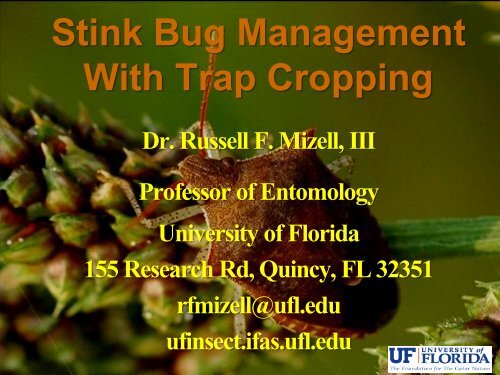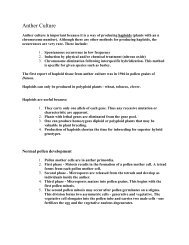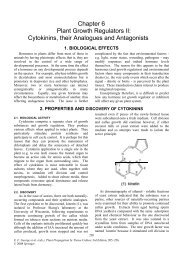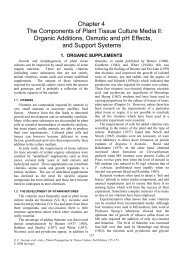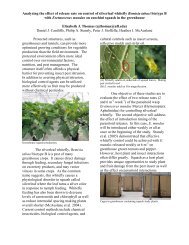Stink Bug Management with Trap Cropping - University of Florida
Stink Bug Management with Trap Cropping - University of Florida
Stink Bug Management with Trap Cropping - University of Florida
Create successful ePaper yourself
Turn your PDF publications into a flip-book with our unique Google optimized e-Paper software.
<strong>Stink</strong> <strong>Bug</strong> <strong>Management</strong><br />
With <strong>Trap</strong> <strong>Cropping</strong><br />
Dr. Russell F. Mizell, III<br />
Pr<strong>of</strong>essor <strong>of</strong> Entomology<br />
<strong>University</strong> <strong>of</strong> <strong>Florida</strong><br />
155 Research Rd, Quincy, FL 32351<br />
rfmizell@ufl.edu<br />
ufinsect.ifas.ufl.edu
4 Major Species <strong>of</strong> <strong>Stink</strong> &<br />
Leaffooted <strong>Bug</strong>s In Southeast<br />
Euschistus servus<br />
Nezara viridula<br />
Chinavia hilaris (was<br />
Acrosternum hilare)<br />
Leptoglossus phyllopus
Euschistus<br />
Thyanta<br />
Banasa<br />
Oebelus<br />
Proxys<br />
Brochymena<br />
*Piezodorus<br />
*Halyomorpha<br />
*Megacopta<br />
*New invasive<br />
species-bad<br />
Other Common<br />
Phytophagous <strong>Stink</strong> <strong>Bug</strong>s<br />
dpughphoto
Common <strong>Stink</strong> <strong>Bug</strong><br />
Immature Life Stages
<strong>Stink</strong> <strong>Bug</strong> Morphology<br />
By Sex (Euschistus servus)<br />
Female<br />
Male
Other True <strong>Bug</strong>s<br />
Acanthocephala femorata<br />
Largus succinctus L.
Predacious <strong>Stink</strong> <strong>Bug</strong>s &<br />
Other Good <strong>Bug</strong>s<br />
From lower left:<br />
Alcaeorrhynchus grandis<br />
Podisus maculiventris<br />
Euthyrhychus floridanus<br />
Apiomerus floridensis
Phytophagous vs Predacious<br />
Plant feeder<br />
‘phytophagous’<br />
Predator
<strong>Stink</strong> <strong>Bug</strong> Natural Enemies<br />
Wasp Egg Parasites & Tachinid Flies
Some Commonalities<br />
• Overwinter as adults – most species<br />
• Polyphagous – >1 host plant species<br />
• Food suitability is ‘qualitative’<br />
• Move through the landscape to find<br />
• Respond to vegetation structure
Some Commonalities<br />
• Have common natural enemies<br />
• Highly tolerant to insecticides<br />
• Relatively little knowledge for some spp.<br />
• Other tools not available – big problem!<br />
• Incremental approach required =IPM
Strategy: Manage Biodiversity<br />
via Vegetation-for Pr<strong>of</strong>it<br />
• Cover crops<br />
• Intercrops, polyculture<br />
• Shelter belts, hedgerows<br />
• <strong>Trap</strong> crops<br />
• Outside orchard influences – crops, etc.<br />
• Spatial configurations? Landscape!<br />
– crop and vegetation plantings<br />
Biodiversity interactions are the engine.
Cover Crop Functions<br />
• Erosion prevention and water holding<br />
(drought remediation)<br />
• Nitrogen enhancement<br />
• Soil organic “matter” increase<br />
• Weed suppression<br />
• Augmentation <strong>of</strong> beneficial arthropods
Cover Crop Side Effects<br />
• Pest increases<br />
– Nematodes<br />
– Arthropods<br />
• Invasive weed outbreaks<br />
• Competition for nutrients, water<br />
• Increased costs - establishment<br />
• More intensive mgmt – timing<br />
• Unexpected consequences?
Cover Crops – Peaches?<br />
Exploiting Habitat Structure & Function,<br />
“Putting the Ecosystem to Work”<br />
• Site- row middles – avoid competition<br />
• <strong>Cropping</strong> season - functions – side effects<br />
• Fruit season – mowed sod + herbicide strip<br />
• Post harvest - grasses, perennial peanut, flowers<br />
– water, weed, nematode control<br />
– soil nitrogen- fall-winter-spring (tree age)<br />
• sun hemp, clovers, legumes, aeschynomene, stylo<br />
– pest targeting - biological control <strong>of</strong> borers, scale?<br />
• expt. – buckwheat, cowpea- flowers, cheap, easy
<strong>Trap</strong> Crops<br />
Exploiting Habitat Structure & Function,<br />
“Putting the Ecosystem to Work”<br />
• <strong>Stink</strong> bug biology, ecology and behavior<br />
• Monitoring methods and results<br />
• temporal<br />
• spatial<br />
• <strong>Trap</strong> cropping details<br />
• temporal<br />
• spatial<br />
• Associated factors – multi-functions
Outside orchard and other<br />
considerations<br />
• Change in crop mosaic yr-yr, etc.<br />
• Phenology change due to weather<br />
• Crops planted near orchard<br />
• Local benefits prob. higher in diversity poor<br />
landscapes<br />
• Biodiversity conservation may be effective in<br />
rich environ., where species occur<br />
• Food web interactions in time and space<br />
<strong>of</strong>ten unpredictable, counterprod.<br />
• Functional scales need to be known
Understanding<br />
<strong>Bug</strong> Behavior & Dynamics<br />
• Phenology<br />
• Food quality<br />
• Movement<br />
Julian Date<br />
• Landscape level processes<br />
– structures<br />
– corridors, barriers, matrices<br />
–‘edge effect’ strong<br />
<strong>Trap</strong> Catch<br />
<strong>Trap</strong> Catch<br />
<strong>Trap</strong> Catch<br />
14<br />
12<br />
10<br />
8<br />
6<br />
4<br />
2<br />
0<br />
14<br />
12<br />
10<br />
8<br />
6<br />
4<br />
2<br />
0<br />
14<br />
12<br />
10<br />
8<br />
6<br />
4<br />
2<br />
0<br />
2000<br />
50 100 150 2001 200 250 300 350<br />
JD<br />
50 100 150 200<br />
2002<br />
JD<br />
250 300 350<br />
50 100 150 200 250 300 350
Monitoring and Detection<br />
• Must have!<br />
• Efficiency – labor, costs<br />
• Statistics – accuracy, precision
<strong>Florida</strong> <strong>Stink</strong> <strong>Bug</strong> <strong>Trap</strong><br />
Dr. Russell F. Mizell, III, Inventor<br />
• Captures many Hemiptera species<br />
– Both phytophagous and predacious<br />
• Visual attraction is primary<br />
• Baits can be easy deployed<br />
• Materials: 4 right triangles<br />
– 1/4” masonite, screen wire,<br />
– 1/4” x 4’ metal rod, twist ties<br />
• “Triangle’s dimensions:<br />
– 4’ high, 11” base, 1” top<br />
• Deploy in the open
<strong>Florida</strong> <strong>Stink</strong> <strong>Bug</strong> <strong>Trap</strong>:<br />
Bare ground <strong>with</strong> open top.<br />
Nothing touching trap.
Commercial <strong>Trap</strong>s Available<br />
<strong>Stink</strong> <strong>Bug</strong> <strong>Trap</strong> - AgBio, Inc.<br />
www.agbio-inc.com/stink-bug-trap.html<br />
url:ufinsect.ifas.ufl.edu
Temporal and Spatial<br />
Distributions<br />
Where are the bugs in<br />
time and space?
NFREC-Quincy Location
Locations <strong>with</strong> High Populations <strong>of</strong><br />
Euschistus servus (scale neutral)
<strong>Trap</strong> Catch<br />
<strong>Trap</strong> Catch<br />
35<br />
30<br />
25<br />
20<br />
15<br />
10<br />
5<br />
0<br />
35<br />
30<br />
25<br />
20<br />
15<br />
10<br />
5<br />
0<br />
Combined Plot Means<br />
2001 Mean <strong>Trap</strong> Catch in Horticultural Plots<br />
Adults<br />
Nymphs<br />
2001 Mean <strong>Trap</strong> Catch in Agronomic Plots<br />
50 100 150 200 250 300 350 400<br />
Julian Date<br />
Adults<br />
Nymphs<br />
•Temporal patterns are not<br />
significantly different,<br />
P = 0.909; Repeated<br />
Measures Analysis<br />
• Note: Nymphs are late instars<br />
only
Movement Mechanisms?<br />
What is driving the behavior ?<br />
How can we exploit it?
Differential Use <strong>of</strong> Sorghum Growth Stages by<br />
E. servus and L. phyllopus
Differential Use <strong>of</strong> Triticale Growth Stages by<br />
E. servus and L. phyllopus
Mean insects per sample<br />
0.6<br />
0.5<br />
0.4<br />
0.3<br />
0.2<br />
0.1<br />
0.0<br />
Differential Use <strong>of</strong> Millet Growth Stages by<br />
E. servus, C. hilaris (Es) and L. phyllopus<br />
Vegetative<br />
Flagging<br />
Millet<br />
A. hilare<br />
Euschistus servus<br />
Leptoglossus phyllopus<br />
Bloom<br />
Milk<br />
Mature
Mechanism<br />
• Food quality very important!!!<br />
– not “preference”*, generalists<br />
• Life stages and species differ<br />
somewhat – very close<br />
• Phenology (timing) related statistic<br />
• Driving variable!<br />
• Application – tools, trap crops
Summary – So Far<br />
• Behavior – understanding required<br />
• Phenology – seasonal abundance<br />
• Food quality change – mechanism<br />
• Spatial distribution changes - time<br />
• Structure is important – literature<br />
– affects movement “perceptual range”<br />
– Edge effect very strong<br />
• Exploitation? Habitat manipulation using<br />
trap crops and other tools.
<strong>Trap</strong> Crop Approach<br />
• Small area w/ highly competitive hosts<br />
• Economical - $$$<br />
• Strategic placement (GIS/GPS)<br />
– adjacent (?) to cash crops (Potting et al. 2005)<br />
– must intercept them!!!!!<br />
• Minimize side effects & mgmt difficulties<br />
• Combine <strong>with</strong> other tactics<br />
• For all growing seasons
Cash<br />
Crop<br />
<strong>Trap</strong><br />
crops<br />
Cash Crop-<strong>Trap</strong> Crop<br />
Coincidence (phenology)<br />
Dec Jan Feb Mar Apr May<br />
++++ ++++ ++++ ++++ ++++ ++++ ++++ ++++<br />
------ ------ ----- ------<br />
------ ----- ------ ------<br />
----- ------ ------ ------<br />
----- ----- ------ -----<br />
------ ----- ------<br />
----- ------ ------<br />
Characters: maturity date, longevity, ratooning, other
What Are the Ideal Features<br />
• Attract required pests (multiple species)<br />
• Seeds available (natives?)<br />
• Economical -$$$<br />
<strong>of</strong> <strong>Trap</strong> Crops?<br />
• Culture & management - seasons<br />
• Minimal side effects (invasive, other pests)
<strong>Trap</strong> Crop Ideal Features, cont.<br />
• Maturity time – length, cv range<br />
• Good duration (ratooning)<br />
• Height – barrier<br />
• Multi-functions (beneficials, poll., wildlife)<br />
• Special note*: native vs exotic plant use<br />
Must have something that works!
<strong>Trap</strong> Crop Specifics<br />
Central & South <strong>Florida</strong>?<br />
Fall-Spring:<br />
• Triticale (crimson clover, h or c vetch (F)- NE)<br />
• Sunflower, buckwheat (Sp), barnyard grass<br />
• Others – citrus related, winter crops<br />
Spring-Fall<br />
• Sorghum, millets, sunflower, buckwheat<br />
– barnyard grass, field peas, okra (pots?),<br />
• Maturity times – multiple CVs<br />
• Ratoon – after heading<br />
• Use multiple tactics
<strong>Trap</strong> Crop Novel Features<br />
• Ratooning = Mowing (like okra in Dade)<br />
– At strategic time<br />
– All plant species NOT amenable<br />
– Saves plantings by extending efficacy<br />
– Saves $$ - less input time & costs<br />
– Negative: same location – double cropping
How to Exploit Sorghum<br />
Maturity Range & Ratooning<br />
Plant <strong>Stink</strong>---------------------<strong>Bug</strong>s<br />
CV1<br />
CV2<br />
CV3<br />
CV4<br />
Physical attributes - cvs?<br />
Height, color, etc.<br />
Functioning Period<br />
Ratoon
<strong>Trap</strong> Crops<br />
Farm Scale and Philosophy Neutral<br />
Where do you place them<br />
relative to the cash crop for interception?
•Fall, early spring planting<br />
•Range in hgt, phenology -cvs<br />
•Beneficials<br />
•All 4 bug species +<br />
•Ratoons<br />
•Hairy/common vetch +<br />
crimson clover = beneficials<br />
**Beneficials=<br />
natural enemies, pollinators<br />
Triticale for Spring
Buckwheat<br />
•Cheap, easy<br />
•Fast maturing – 4-5 wks<br />
•Ratoon, easy plant<br />
•Soil temp, frost – good<br />
•All 4 species +<br />
•Organic crop<br />
•“RELAY” crop<br />
•Beneficials!!
•Maturity- 70-90 days<br />
•Soil temp & frost -kills<br />
•Ratoons well<br />
•Germplasm – variable<br />
•All 4 species +<br />
•Beneficials<br />
•Pots<br />
•Organic<br />
Sorghum
•Cheap, easy<br />
•Low soil temp & frost - bad<br />
•Ratoons<br />
•70-90 days to maturity<br />
•Beneficials<br />
•Pots<br />
•Germplasm- variable<br />
•Organic crop<br />
•All 4 species +<br />
Pearl Millet
•Cheap, easy<br />
•Low soil temp & frost - good<br />
•Beneficials!!!!!<br />
•Containers<br />
•Germplasm- variable<br />
•Organic crop, biodiesel<br />
•Ratoon- no<br />
Sunflower
Japanese Millet: ’Barnyardgrass’<br />
Echinochloa crus-galli<br />
•Cheap, easy<br />
• Maturity 6-7 weeks<br />
•Beneficials<br />
•Containers<br />
•Germplasm<br />
•All 4 species +<br />
•Short attraction time<br />
•3-4’ in height<br />
•Can be invasive - aquatic
Other Species w/Potential?<br />
Field Peas<br />
• Cheap - easy<br />
• Extrafloral nectaries<br />
• Previous work+<br />
• Height-short; trellis?<br />
• Cultivars<br />
Field Peas & Okra<br />
Okra: (containers)<br />
•Cheap, must manage!<br />
•Beneficials, EFN<br />
•Rootknot nematodes neg.<br />
•Ratoons
Other Species w/Potential?<br />
Hemp Sesbania (Y/N?),<br />
Hairy Indigo, Crotolaria – (N)<br />
Hemp Sesbania: ??<br />
•Height – tall - barrier<br />
•Not all SB species<br />
•Oebalus spp.<br />
•Invasive<br />
Hairy indigo – weedy,<br />
nematode suppressor+<br />
Showy Crotalaria-<br />
poisonous to cattle
Other Species w/Potential?<br />
Browntop Millet – No; Wildlife<br />
• Cheap, easy<br />
• Doesn’t last long<br />
• 5-6 weeks<br />
• Height - short<br />
• Attracts beneficials, pollinators<br />
•+Oebalus spp.<br />
•Weedy - invasive<br />
Japanese
Containers for Portability,<br />
Visual/chemical Cues Enhance<br />
Yellow trap –Attraction - 4X<br />
increase in H. axyridis
<strong>Trap</strong> Crop Summary<br />
Fall-Spring:<br />
• Triticale (crimson clover, hairy vetch) (F)<br />
• Sunflower, buckwheat (Sp), field peas, okra<br />
Spring-Fall<br />
• Sorghum, millet, sunflower, buckwheat<br />
– okra, field peas, others<br />
• Multiple species and cultivars<br />
• Ratoon – after heading<br />
• Portable containers, greenhouse starts<br />
• Remove pests: by hand, vacuum or spray<br />
• Add in other tools: traps, pheromones, BC, etc.
Some Other Ideas<br />
Physical properties, barriers:<br />
• Height -trap crop via cultivar selection<br />
• Configuration <strong>of</strong> plants<br />
– short to tall toward cash crop<br />
– density <strong>of</strong> trap crop plants<br />
• Trellis <strong>of</strong> vines like field peas - height<br />
• Exploit visual components<br />
– Use <strong>of</strong> visual repellent – UV mulch<br />
– Use best colored cultivar<br />
• Artificial materials – netting, etc.
Brown Marmarated <strong>Stink</strong> <strong>Bug</strong><br />
• Invasive pest, like few others!<br />
• Double whammy – plants and buildings<br />
• Major research efforts underway in<br />
conventional and organic<br />
• <strong>Trap</strong> crops: are being developed and<br />
tested. Look to have promise.<br />
• Various cucurbits and others? TBD
<strong>Trap</strong> Crop Spatial Orientation<br />
Interplanting- NO!!!<br />
Edge Interception – Yes!
Spatial Configurations<br />
Unknowns<br />
Default – Ring It<br />
<strong>Trap</strong> Crop<br />
Cash<br />
Crop<br />
Plot size: one tractor<br />
implement width<br />
Aerial Plats<br />
With Knowledge:<br />
Source- Sink Approach<br />
Open fields<br />
Open fields<br />
Cash Crop<br />
Open fields<br />
Crop<br />
Source<br />
Open fields
<strong>Management</strong> in the <strong>Trap</strong> Crop<br />
• Insecticides ?<br />
• Mechanical<br />
– by hand<br />
– sweep net<br />
• Vacuum device<br />
• Blower – catcher<br />
4’ x 7’<br />
PVC<br />
frame <strong>with</strong><br />
netting +<br />
blower
Mean per sweep <strong>of</strong> <strong>Stink</strong> and Leaffooted <strong>Bug</strong>s<br />
5<br />
4<br />
3<br />
2<br />
1<br />
0<br />
<strong>Trap</strong> Crop Efficacy,<br />
Edge <strong>of</strong> Organic Soybean<br />
Mean Total <strong>Stink</strong> and Leaffooted <strong>Bug</strong>s<br />
Organic Soybean<br />
<strong>Trap</strong> crops<br />
220 240 260 280 300 320 340<br />
Day <strong>of</strong> the Year
Research: Multifunctional Plots<br />
Augment Ecological Services
The End<br />
Thank You!<br />
Questions<br />
ufinsect.ifas.ufl.edu<br />
rfmizell@ufl.edu


